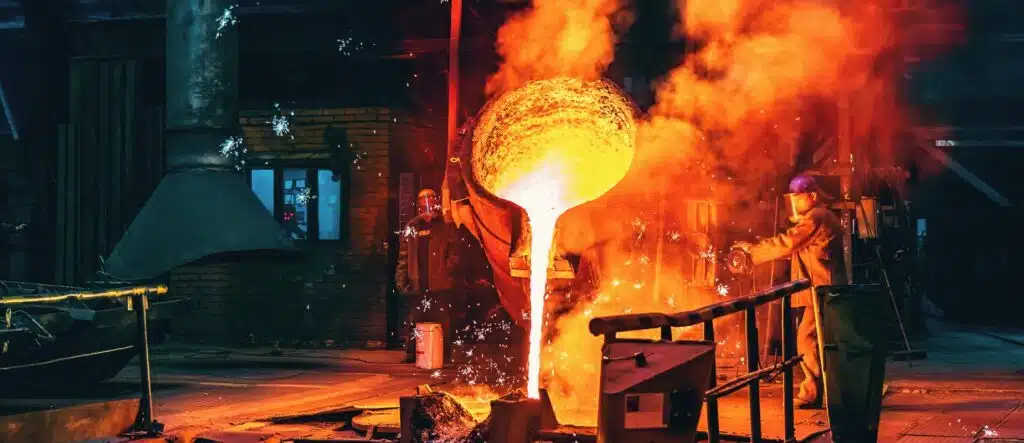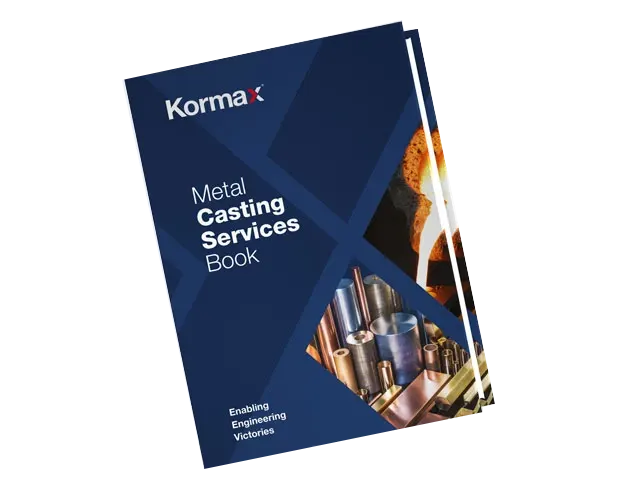Sand casting is a versatile process that can produce a variety of products of different sizes, shapes, and intricacies. Sand moulds are reasonably inexpensive and highly refractory even for steel foundry use, which is why sand casting accounts for 60% of all metal castings. For the cost-effective production of small-sized lots, sand casting is considered the method of choice by manufacturing industries.
Sand Casting Process
There are various steps to the sand casting process in general. The most common stages in sand casting are discussed below.
Preparation of Pattern
The mould shaping tool used by the manufacturers is called a pattern. Pattern making is the foremost step in metal casting. These patterns are used for creating cavities in the moulds that resemble the shape of the product. Patterns can be made of different types of materials including wood, gypsum cement, plaster, aluminum, steel, and plastics. The most common and frequently used material for pattern making is wood. Usually, two pattern halves are made separately and assembled to form cavities. If interior contouring is required, cores that are inner mould inserts can also be employed. These cores cannot be used again and are discarded after one casting. Once the pattern is prepared, its surface is coated with either paints or metal coatings. These coatings facilitate the removal of patterns from the mould without causing any distortion in the created impressions. Some examples of paints are lacquers, epoxies, and polyurethanes while examples of metal coatings include chromate and nickel-based coatings.
Preparation of Sand Mould
As the name suggests, the sand casting technique uses sand for the creation of a mould that is held together with a binding agent. Sand casting is an expandable mould casting which means that the mould is temporary. The sand mould is typically created in two parts, with each side using one pattern. Even though the mould might not always be in pairs, this configuration offers the simplest approach to making the mould and accessing the part once it has been cast. The top portion of the mould is called the “cope,” while the bottom portion is called the “drag.” The sand is mixed with the bonding agent and both portions of the mould are created by compressing sand into a container around the patterns to get a negative impression of the required part. The sand must be tightly packed either by vibration, ramming machine or by hand to avoid any loose sand. After removal of the patterns, the gates or runners are created in the drag while a funnel or sprue is created in the cope that allows the liquid metal to flow into the mould and fill all cavities. In the final step of the mould making, the cope and drag are clamped together to create a complete mould. The meeting point of the two halves of the mould forms the parting line.
The moulding media should acquire good green strength, flowability, and uniform density. Good green strength is required for the easy removal of patterns from the mould without any distortion. The green strength and flowability of the moulding media depend on the type of materials and methods used for compaction during the mould making.
Melting and Pouring of Metals/Alloys
The desired metal or alloy is melted in the furnace and subsequently poured into the sprue of the mould where it is directed to the cavities created by the patterns. During the solidification process, the risers provide the necessary molten metal to compensate for the shrinkage. Sand casting has a slow cooling rate as molten metal is surrounded by the insulating sand. Once the metal is solidified, the mould is split open to remove the casting part via vibrations, or other non-destructive sources. The casting industries are enhancing the automation level of the sand-casting process to control the quality and increase the production rate.
Cleaning and Finishing
Cleaning and polishing the solidified product are the last steps in the sand casting process. The runners, gating system, and any remains of the mould are all removed from the product during this cleaning process. The surface of the casting is then ground and polished to the required finish. Here, the rough component is shaped to its ideal form.
Inspection
After a thorough cleaning, each component is checked for flaws and put through a series of tests to make sure it meets quality standards, ensuring it will function properly during service.
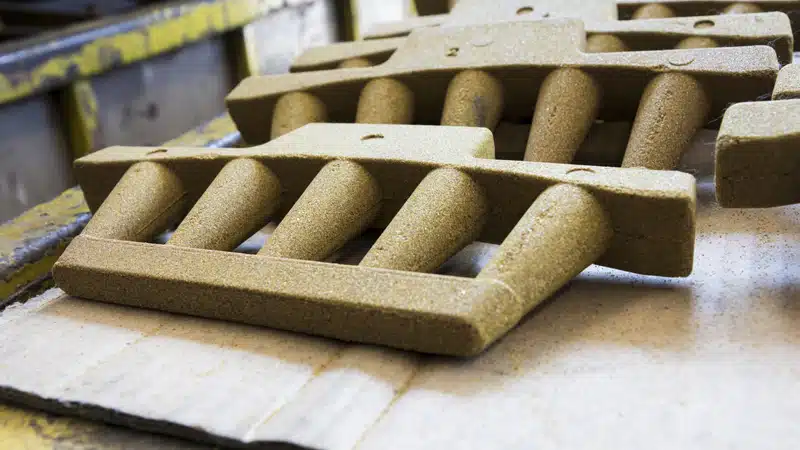
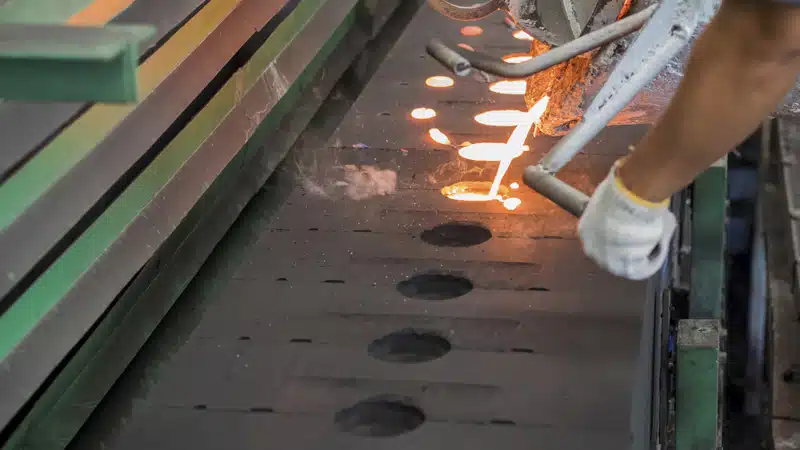
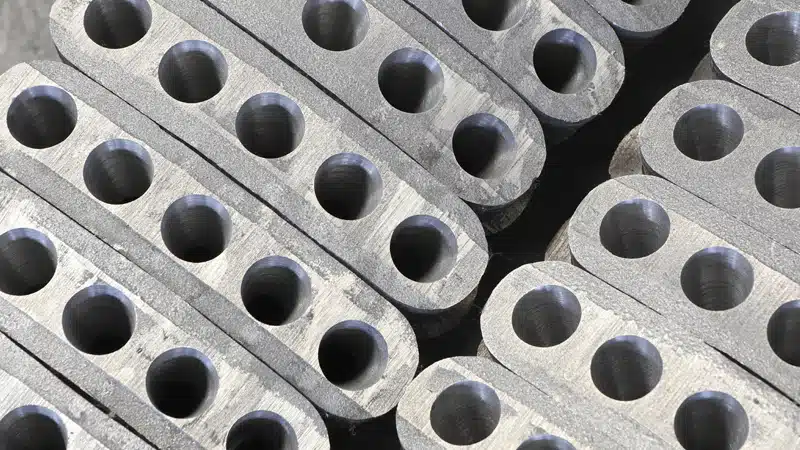
Sand Mould Materials
Different materials are used for making sand moulds. The most common materials are discussed below.
Sands
There are various types of sand casting depending on the type of sand and the binder used for holding that sand. Different types of sands and synthetic aggregates are used in different sand moulds. Silica sand (SiO2) is the most common and abundant material in nature and has good moulding features due to which it is frequently used in casting industries for making sand moulds. Some other sands used for sand moulds are olivine, chromite, and zircon. Chromite and zircon sands show high conductivity while their thermal expansion is low. The mechanical properties and soundness of casting are enhanced because of the high thermal conductivity of these sands.
Synthetic Aggregates
Alumina, mullite, and bauxite are synthetic aggregates that can be used for sand casting special applications. These synthetic aggregates are spherical and are not only hard but have good wear resistance which makes them ideal for mould making. Since these materials are more expensive than natural sand, it is necessary to recycle moulds to make the sand-casting process more economical.
Binding Systems
Several types of binding systems including green sand, chemically bonded sand, and an inorganic binder system are used for binding the sand to get the desired moulding features. Green sand is the simplest binding system which consists of water, bentonite, and sand. It can be mixed with other additives too if required. The advantages of using green sand in mould making include ease of recycling and cost-effectiveness. In chemically bonded sand, synthetic binders are used. This system is considered more suitable compared to others for casting complex shapes with thin walls. With the ease of moulding, the chemically bonded sand moulds provide a good surface finish which means that less ramming and cleanliness are required after removing products from the mould. The inorganic binders, such as bentonite, tend to reduce the chemical release in the atmosphere and gas formation during the casting process. However, these are hydrophilic in nature with low binding strength that requires extra care during the casting process.
Sand Casting Materials
Ferrous and nonferrous alloys are two categories of metals used in sand casting. The base material for ferrous alloys is iron (ferrous), whereas the base material for nonferrous alloys is a different metal. Ferrous alloys commonly cast by this method include white cast iron, gray cast iron, ductile iron, martensitic stainless steel, austenitic stainless steel, duplex stainless steel, low alloy steel, and low carbon steel. Nonferrous alloys with a copper or aluminum base are frequently utilized in sand casting. Alloys of aluminum that exhibit hot shortness and highly reactive magnesium can also be moulded using this technique. Other materials and alloys which could also be made in sand casting include lead, zinc, tin, refractory alloys, titanium alloys, beryllium alloys, and zirconia alloys.
Types of Sand Casting
Sand casting can be categorized into several types, some of which are discussed below.
Hard Sand (No Bake) Casting
Hard sand casting is the major sand-casting technique that involves the casting of metals and alloys using hard moulds. The refractory sand is hard bonded by resins to lock the sand grains around the pattern. The molten metal is poured into the hardened sand moulds to obtain smooth, consistent, accurate, and low defective castings.
Green Sand Casting
Green sand casting is a type of sand casting in which the sand is bonded with bentonite. Here, the word “green” refers to the fact that the products are uncured, which means the sand has not been baked. It is among the most popular and economical types of sand casting. The disadvantage of green sand casting is its lower strength and higher moisture content.
Shell Sand Casting
In case of shell sand casting, the skin of the mould cavities is dried by using gas torches or heaters. The moisture content is removed from the cavities to a depth of 25 mm. This method is cost-efficient as it requires less tooling and consumes less time. Like investment casting shell sand casting is very accurate and little machining is required. Surface finish is improved in comparison to hard sand (No-bake) casting. The biggest constraint is regarding geometry (suitable for smaller components) and design limitations.
Design Consideration
Some of the important design considerations for sand casting are given below.
- To avoid shrinkage and prevent stress concentration, each intersecting point must be filleted.
- The gating system must be designed appropriately for the proper transfer of molten metal into the mould cavities.
- The parting line should be horizontally flat and positioned as low as possible.
- Machining allowance should be kept in mind while casting that is normally in the range of 1.5 mm to 6 mm.
- The draft angle is normally taken between 3° to 5°.
- The minimum section thickness is typically 5 mm (about 0.2 in) for light nonferrous alloys and 6 mm for ferrous alloy.
- The cast object’s weight may range from 0.5 to 20,000 kg (about 44092.4 lb) with a minimum run weight of 300 kg (about 661.39 lb).
Conclusion
Sand casting is the oldest metal casting process in human history. It is a versatile and cost-effective process that can produce a variety of products of varied sizes, shapes, and intricacies. Sand moulds are reasonably inexpensive and highly refractory even for steel foundry use. Sand casting is the best method for producing castings in low and medium volumes as well as casting welded parts.
Visit our website to view our Sand Casting capabilities and contact Kormax’s experienced team to discuss your Sand Casting requirements.
